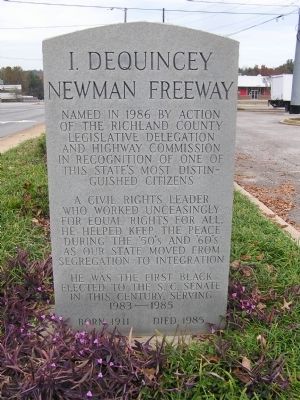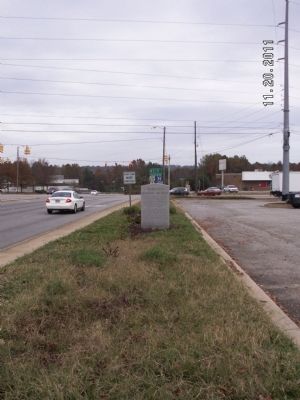Midtown - Downtown in Columbia in Richland County, South Carolina — The American South (South Atlantic)
I. DeQuincey Newman Freeway
A Civil Rights leader who worked unceasingly for equal rights for all, he helped keep the peace during the '50's and '60's as our state moved from segregation to integration
He was the first black elected to the S.C. Senate in this century, serving 1983 ~ 1985
Born 1911 Died 1985
Topics. This historical marker is listed in this topic list: Government & Politics. A significant historical year for this entry is 1986.
Location. 34° 1.417′ N, 81° 2.261′ W. Marker is in Columbia, South Carolina, in Richland County. It is in Midtown - Downtown. Marker is on Bull Street near Harden Street Extension, on the right when traveling north. Touch for map. Marker is in this post office area: Columbia SC 29201, United States of America. Touch for directions.
Other nearby markers. At least 8 other markers are within walking distance of this marker. Geiger Ave. Cemetery (about 600 feet away, measured in a direct line); S.C. Confederate Soldiers’ Home (approx. 0.2 miles away); Confederate Soldiers Home (approx. 0.2 miles away); Site of the Surrender of Columbia, SC (approx. half a mile away); South Carolina State Hospital (approx. 0.6 miles away); South Carolina State Hospital, Mills Building (approx. 0.7 miles away); Modjeska Simkins House (approx. 0.7 miles away); 1900 Block of Henderson Street / William J. Sumter (approx. ¾ mile away). Touch for a list and map of all markers in Columbia.
Additional commentary.
1. I. DeQuincey Newman
As one travels up Bull Street in Columbia, just before the Harden Street intersection, there is a plain granite monument dedicating SC 277 as the “I. DeQuincey Newman Freeway” so the question becomes, who was I DeQuincey Newman?
The short answer is he was one of South Carolina’s important leaders during the Civil Rights Era, and he was the first African-American to be elected to the South Carolina State Senate since Reconstruction. But there’s a little more to the story.
Newman, known as “I.D.”(1911-1985),was born in Darlington County in 1911. After graduating from Clark College in Atlanta, Newman became an ordained Methodist minister. While serving as a student pastor to a congregation of sharecroppers in Red Oak, Georgia, Newman attempted to persuade a plantation owner to put an extremely sick sharecropper in the hospital. Newman was greeted by a shotgun and told to get out.
Moving back to South Carolina in 1937, Newman was instrumental in organizing the Orangeburg chapter of the NAACP in 1943. From there, Newman held a series of leadership positions. As the Civil Rights struggle hit the headlines, Newman became the Field Secretary for the South Carolina chapter of the NAACP. Using diplomacy rather than confrontation, Newman was successful in keeping the violence to a minimum. But Newman was no pushover, in the words of Jack Bass, a newspaperman of the time, “he knew when to push and how far to push.”
In 1969, Newman stepped down as NAACP head and returned to preaching and also served as a commissioner of the South Carolina Housing Authority. In 1983, he was elected to the State Senate and served for 2 years, resigning because of ill health. He died a short time later.
Newman is remembered in a variety of ways, with the I DeQuincey Newman Institute for Peace and Social Justice at the University of South Carolina and the aforementioned monument on the side of the road.
— Submitted November 22, 2011, by Anna Inbody of Columbia, South Carolina.
Credits. This page was last revised on February 16, 2023. It was originally submitted on November 22, 2011, by Anna Inbody of Columbia, South Carolina. This page has been viewed 788 times since then and 41 times this year. Photos: 1, 2. submitted on November 22, 2011, by Anna Inbody of Columbia, South Carolina. • Craig Swain was the editor who published this page.

